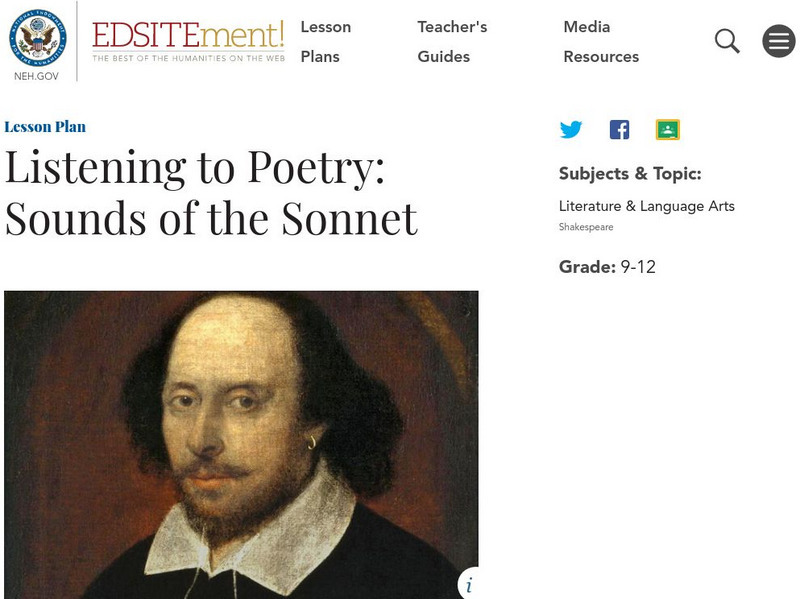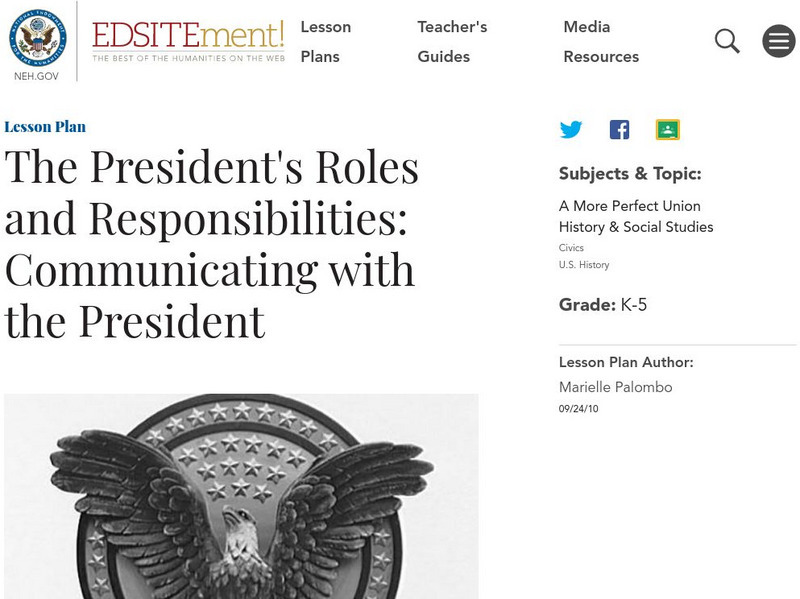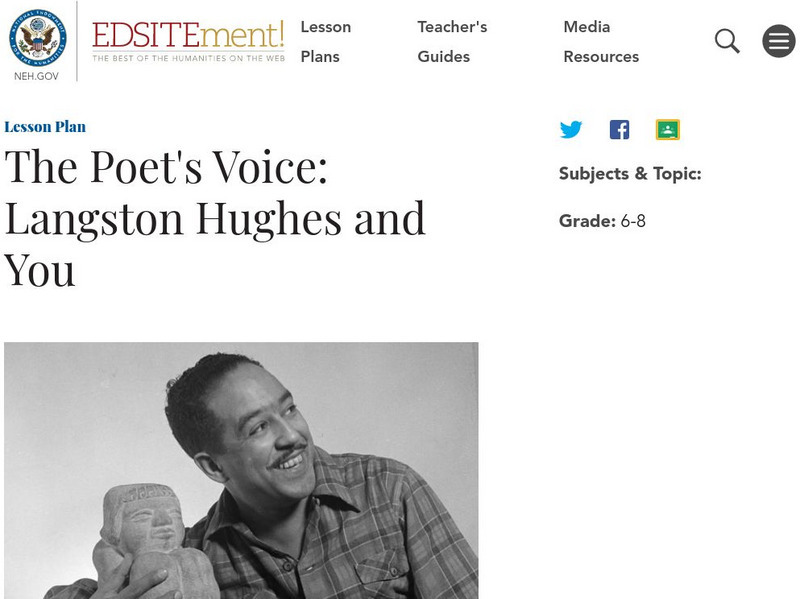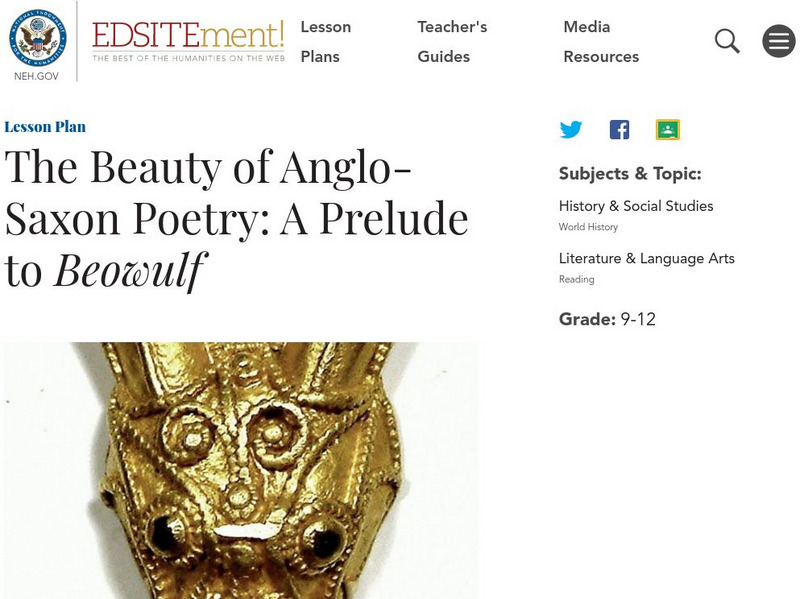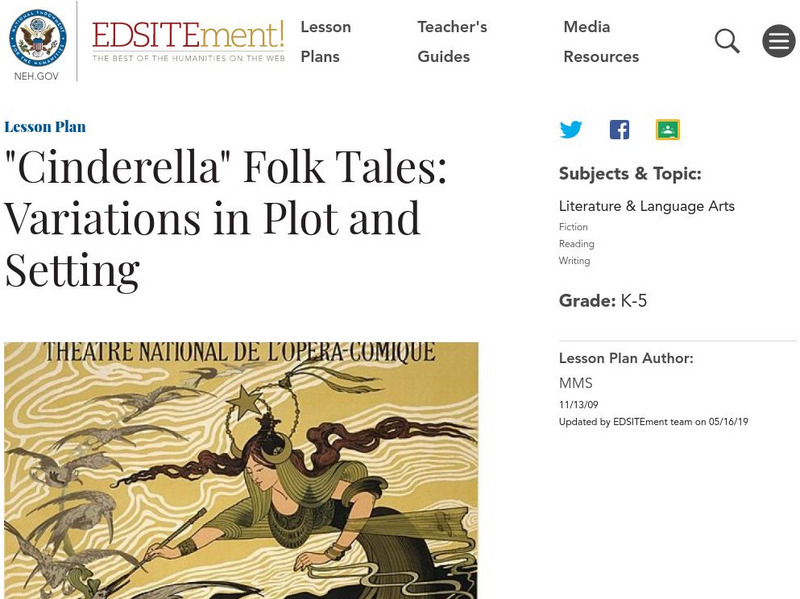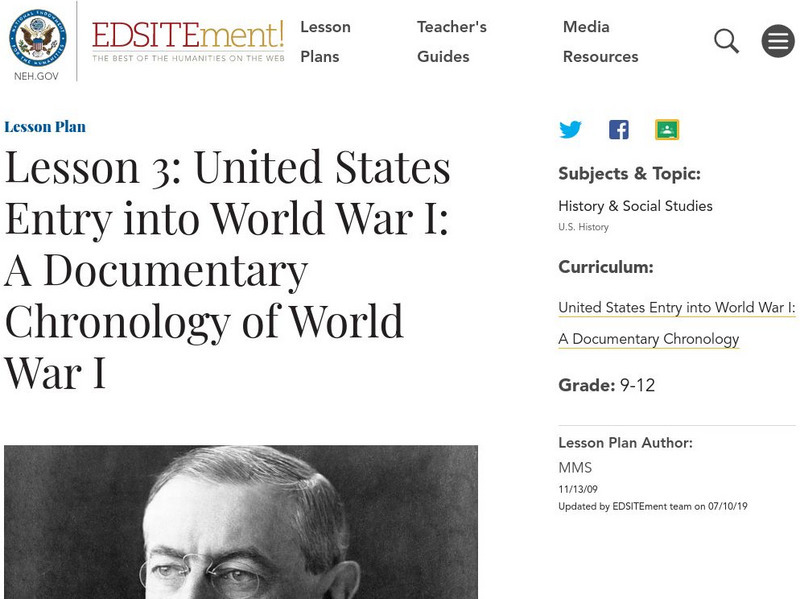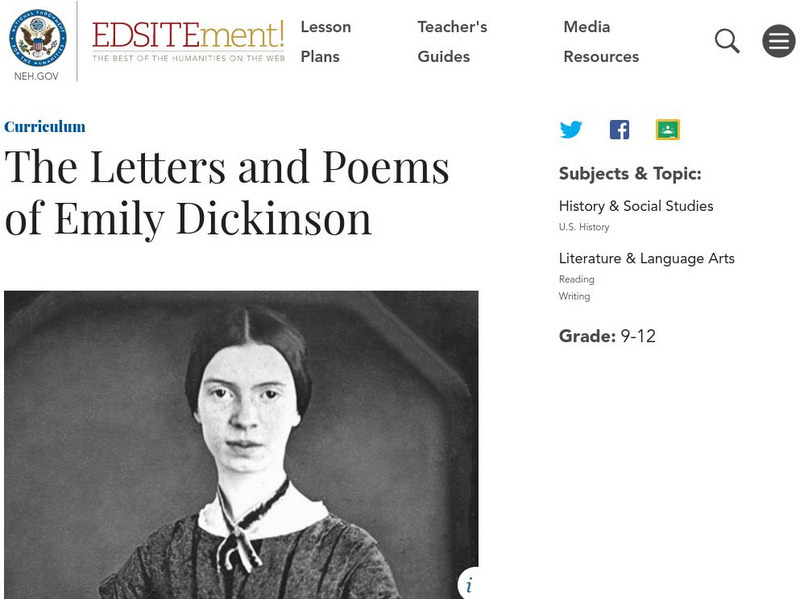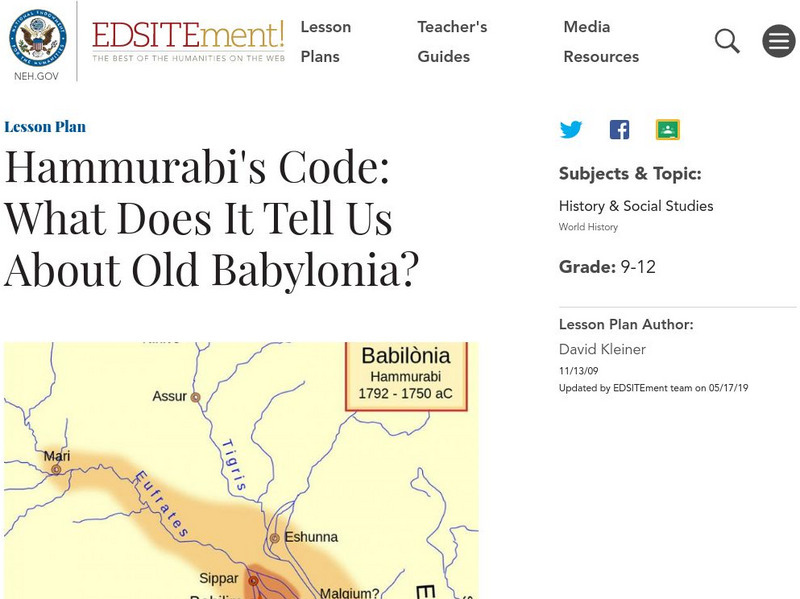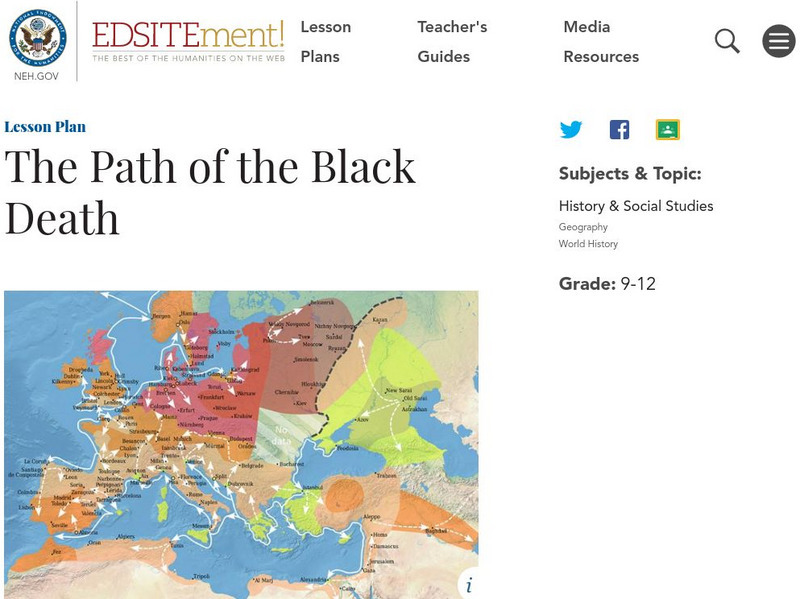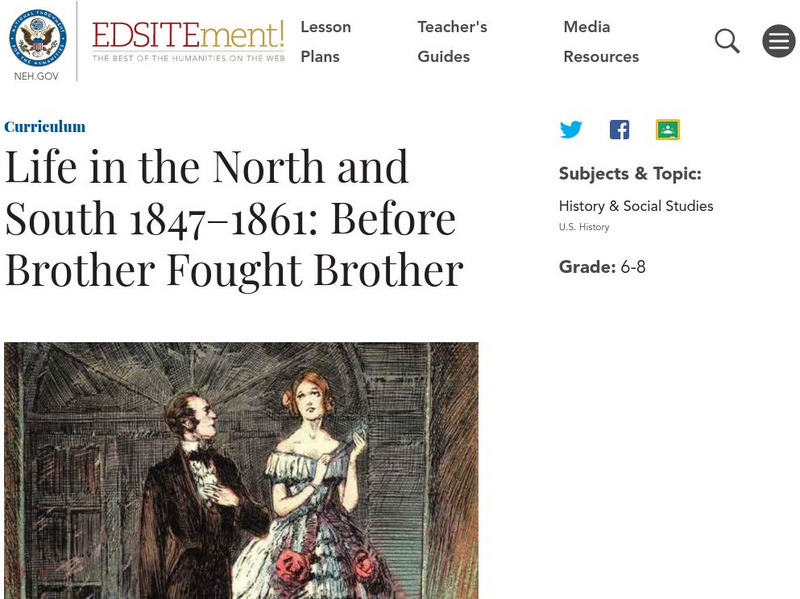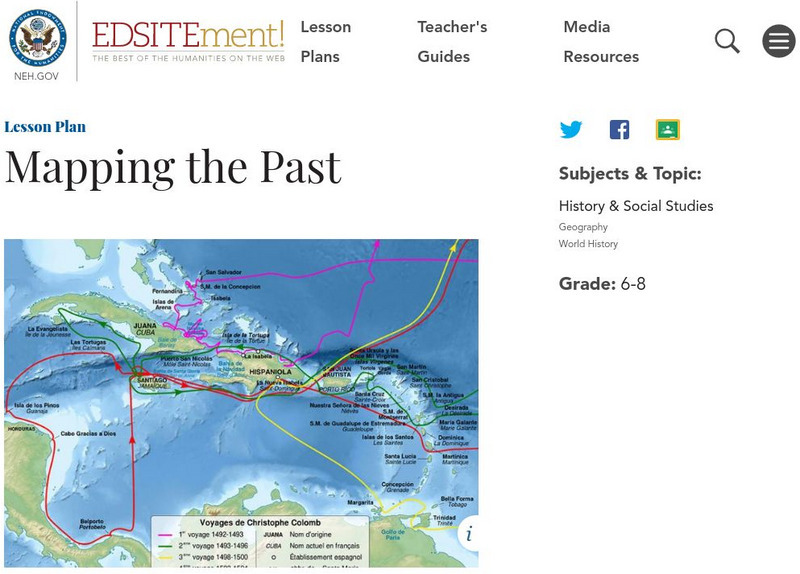Hi, what do you want to do?
National Endowment for the Humanities
Neh: Edsit Ement: Civil Rights Movement
This lesson plan on the Civil Rights movement is organized into three sections: "Identifying the Need for Change," "Ordinary People in the Civil Rights Movement," and "Historic Places in the Civil Rights Movement."
National Endowment for the Humanities
Neh: Edsit Ement: Cave Art Discovering Prehistoric Humans
By studying cave paintings, students learn about prehistoric cultures and the stories and ideas they wished to communicate to others through art. The lesson plan presented on this website aims to show young students the significance of...
National Endowment for the Humanities
Neh: Edsit Ement: Sounds of the Sonnet
"Sound Experiments" drive this lesson plan. Sonnet analysis is accompanied by readings based on specific emotions. At this website, there are several links full-text sonnets by such authors as Shakespeare, Lord Byron, Longfellow, and...
National Endowment for the Humanities
Neh: Edsit Ement: Sounds of the Sonnet
This resource presents a lesson in which students learn to study the form, sounds, and meanings of sonnets (particularly those by Shakespeare) in an interesting and interactive way.
National Endowment for the Humanities
Neh: Edsit Ement: Traditions and Languages of Three Native Cultures
This lesson plan helps students learn aspects of three Native American languages, the Tlingit, Lakota, and Cherokee. Five lessons lead teachers and students through traditions, similarities and differences, and the importance of...
National Endowment for the Humanities
Neh: Edsit Ement: Communicating With the President
Students will be able to apply knowledge about the writing process in this lesson plan about communicating with the President of the United States. Presidential Resources, academic content standards and ways to extend the lesson are...
National Endowment for the Humanities
Neh: Edsit Ement: Understanding the President's Job
What does the President do? Understanding how our democracy works includes understanding how the Executive branch of our government works. Teachers can use this lesson plan to explore with students the job of the President. Academic...
National Endowment for the Humanities
Neh: Edsit Ement: Lesson Plan: Arabic Poetry
This online lesson plan introduces information about the Arabic poetic art form known as the ghazal. It includes Educational Objectives, classroom activities and projects, examples, and a list of the relevant national educational standards.
National Endowment for the Humanities
Neh: Edsit Ement: Japanese Poetry Tanka? You're Welcome
A poem "which expresses a personal response to nature," the tanka is a form of Japanese writing very similar to the haiku. This lesson plan is a great extension to any study or exploration of Japanese art, culture, and writing. Included...
National Endowment for the Humanities
Neh: Edsit Ement: Shakespeare's Othello and the Power of Language
A lesson plan focusing on the power of Iago's language, as shown through his crafty deception of Othello, "Shakespeare's Othello and the Power of Language" provides several links to information on Shakespeare, Othello, and rhetoric.
National Endowment for the Humanities
Neh: Edsit Ement: The Poet's Voice: Langston Hughes and You
What is meant by voice in poetry, and what qualities have made the voice of Langston Hughes a favorite for so many people? This lesson will lead students to learn about the qualities that make Langston Hughes's voice distinctive,...
National Endowment for the Humanities
Neh: Edsit Ement: A Prelude to Beowulf
Before reading the Anglo-Saxon epic poem, "Beowulf," students should explore the Dark Ages through researching the fundamental characteristics of the art and literature produced during this period. This website provides links for doing...
National Endowment for the Humanities
Neh: Edsit Ement: Variations in Plot and Setting
Although Disney's version of Cinderella is most popular in America, hundreds of versions exist across many cultures. This resource provides lessons, which examine the similarities and differences in literary elements among many versions...
National Endowment for the Humanities
Neh: Edsit Ement: u.s. Entry Into World War 1: Curriculum Unit
A teacher-directed curriculum unit that deals with the issue of why the United States entered World war 1. Includes an extensive list of additional resources and activities.
National Endowment for the Humanities
Neh: Edsit Ement: Trekking to Timbuktu: Mansa Musa Takes a Trip
Trekking to Timbuktu is a WebQuest for Grades 6-8. Mission 4 looks at Mansa Musa's journey to Mecca in 1324.
National Endowment for the Humanities
Neh: Edsit Ement: Letters From Emily Dickinson
Excellent lesson plan in which young scholars study and analyze the letters that Emily Dickinson wrote to Thomas Higginson and to her sister-in-law, Susan Huntington Gilbert Dickinson, as a method of understanding her poetry in a deeper...
National Endowment for the Humanities
Neh: Edsit Ement: Hammurabi?s Code: What Does It Tell Us About Old Babylonia?
A complete lesson unit on Hammurabi?s Code, for Grades 9-12.
National Endowment for the Humanities
Neh: Edsit Ement: The Path of the Black Death
The Black Death caused a radical alteration in population and dramatic changes in society. In this instructional activity, students will analyze maps, documents, and firsthand accounts to trace the effects of the Black Death in Europe.
National Endowment for the Humanities
Neh: Edsit Ement: Chinua Achebe's Things Fall Apart
Three detailed lesson plans for high school students studying Chinua Achebe's novel "Things Fall Apart." Provides plenty of resources, such as links, lesson extensions, and more.
National Endowment for the Humanities
Neh: Edsit Ement: George Orwell's Essay on Life in Burma: "Shooting an Elephant"
This is a lesson plan for George Orwell's Essay on his Life in Burma: "Shooting An Elephant." It provides five detailed activities for use with the essay. Other links to parts of the lesson plan including an introduction, guiding...
National Endowment for the Humanities
Neh: Edsit Ement: The First Great Awakening
In the middle of the 18th century, a series of evangelical religious revival movements swept across colonial America. Known as the First Great Awakening, the movements were characterized by emotional religious conversions from a state of...
National Endowment for the Humanities
Neh: Edsit Ement: Life in North & South 1847 1861: Before Brother Fought Brother
The five lessons in this unit are designed to help students develop a foundation on which to understand the basic disagreements between North and South through the investigation of primary source documents, photographs, and census...
National Endowment for the Humanities
Neh: Edsit Ement: Woodrow Wilson and Foreign Policy
In this curriculum unit, students will consider "Woodrow Wilson and Foreign Policy" in 4 Lessons. The unit also includes worksheets and other student materials that can be found under the resource tab.
National Endowment for the Humanities
Neh: Edsit Ement: Mapping the Past
Students will examine European world maps from the Middle Ages, the Age of Discovery, and the period of New World exploration. They will then look at maps that record the early exploration of the American West and collect present-day...








